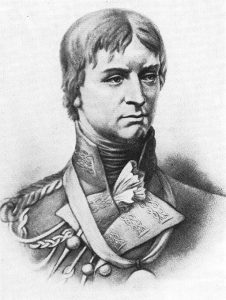Major-General Robert “Black Bob” Craufurd


Unknown Author, Public domain, via Wikimedia Commons
Major-General Robert Craufurd was an extraordinary man with an extensive military career who commanded a light brigade in Wellington’s army, later the Light Division. Thanks to his fiery temper and his tendency towards strict discipline, he earned the nickname ‘Black Bob’. Despite his intimidating reputation, Craufurd was an able and brave commander, and earned great respect from his men through his bravery and his iron resolve. Time and again throughout his military career, Craufurd proved his bravery, his resolve, and his unyielding dedication.
The Retreat to Vigo: Order in the Face of Chaos
As Moore’s army advanced into Spain in 1809 to confront the French forces, they found themselves outmanoeuvred and outnumbered. With orders to retreat to Corunna, the British army faced a long and gruelling march through snow and freezing rain, harassed as they went by the French. Craufurd’s brigade formed part of the rearguard, covering the main army’s retreat before splitting off to retreat to Vigo.
Craufurd’s strict leadership and discipline were crucial in maintaining order among his troops during the otherwise chaotic retreat. In spite of the urgency of the march, he even gathered his men to witness floggings for minor offences.
Although severe and unrelenting, it was Craufurd’s staunch resolve to keep his brigade in check that saw them reach Vigo exhausted and weak but relatively intact, having provided vital cover for the retreat of the British forces.

The March to Talavera: Determination at Any Cost

Map of the Battle of Talavera (1809), Public Domain, via the British Library
Soon enough, Craufurd and his Light Brigade returned to the Peninsula, delayed by bad weather, to meet Wellington at Talavera. Knowing that time was of the essence, Craufurd set out to lead his brigade on what would prove to be a truly arduous journey.
In the sweltering summer heat, the brigade embarked on a relentless march lasting twenty-six hours, covering a daunting forty-five-mile distance. Fuelled by Craufurd’s unwavering resolve and spurred onward by the distant sounds of battle, they pressed ahead. Despite their remarkable speed and endurance, their efforts proved futile; they arrived too late to participate in the battle.
This endeavour epitomised Craufurd’s indomitable spirit. Although Craufurd and his men missed the opportunity to directly influence the outcome at Talavera, Craufurd’s leadership and the resilience of his men served as a testament to their steadfast bravery and fortitude.
The Battle of Fuentes de Oñoro: The Culmination of Discipline
In May 1811, the Battle of Fuentes de Oñoro pitted Wellington’s Allied forces against Marshal André Masséna’s French army in a struggle for control of the strategically important village.
When Masséna launched a formidable assault on Wellington’s exposed right flank, the situation became dire. In response, reinforcements were urgently dispatched to bolster the vulnerable 7th Division, and Craufurd’s esteemed Light Division was personally chosen by Wellington for this pivotal task.
The 7th Division desperately needed cover to allow them to fall back to a stronger position. The Light Division, supported by cavalry, enacted a textbook fighting retreat to allow their safe withdrawal. Time and again the French cavalry threatened the Allied forces, driven off by cavalry charges and the unyielding squares of Craufurd’s infantry that stood as an impenetrable bulwark against the onslaught. With trifling casualties, the 7th Division was able to withdraw.
In the face of determined aggression and superior numbers, it was the precise and well-trained manoeuvres of the Light Division that proved instrumental in preventing significant loss of life. Craufurd’s famed severity had paid off; the Light Division under his leadership exhibited supreme bravery and discipline.
Death & Legacy

Archibald Forbes, Arthur Griffiths and others, Public domain, via Wikimedia Commons
By January 1812, Craufurd had been promoted to Major-General. Wellington’s forces were gathered at Ciudad Rodrigo, besieging the city’s French garrison. With two breaches blasted into the wall by heavy artillery, Wellington ordered a direct assault.
Craufurd and his Light Division were sent to storm the lesser breach and it was there, whilst standing on the glacis, that he fell mortally wounded. Carried off the battlefield by his staff officer, Craufurd lasted another four days before succumbing to his wounds.
He was buried in the very breach of the fortress where he had met his death. Though remembered as a stern disciplinarian, his legacy was one of inspiration and his steadfast courage earned the unwavering respect of all who served under his command. Marching on after his funeral, the Light Division came across a marshy pool around which the road looped. Remembering that in life

Mural Monument to Major General Robert Craufurd (1764–1812) and Major General Henry MacKinnon (1773–1812) by John Bacon II (1777–1859), photo credit: St Paul’s Cathedral, licensed under CC BY-NC
Craufurd had never allowed a formation to be broken or diverted simply to avoid physical discomfort, the leading files marched straight ahead, thigh deep in icy water. Every officer and man followed in silence in a touching tribute to Craufurd’s unyielding resolve.
Craufurd’s legacy lives on long after his death. In WWI, a Lord Clive class monitor was named HMS General Craufurd in his honour. He is commemorated in St Paul’s Cathedral alongside Major General Henry MacKinnon in St Paul’s Cathedral, who also lost his life during the siege of Ciudad Rodrigo.
